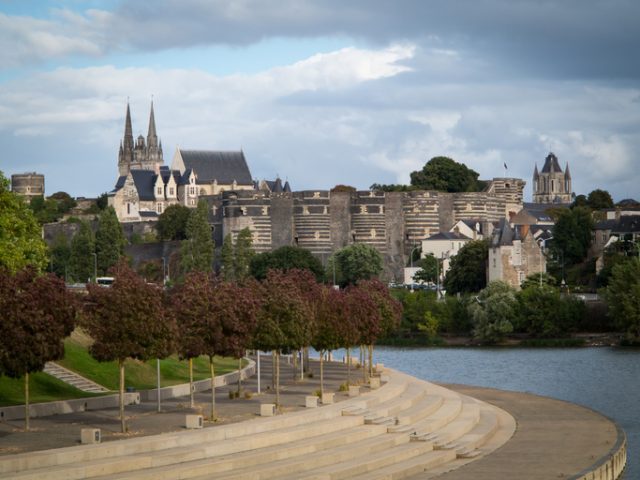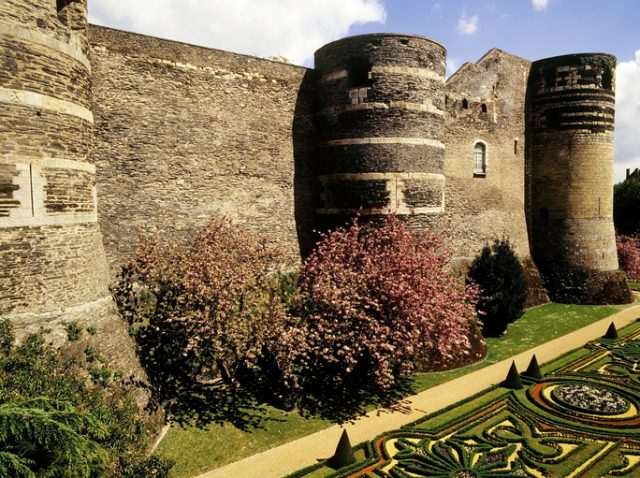The most famous landmark in the French city of Angers is the remarkable castle next to the Maine River. Cháteau d’Angers has a long history linked to prominent people. Its beginnings date back to ancient times when the region was inhabited by Celtic people.
When the Romans attacked the region, the Celts lost the battle and it became part of the Roman Empire. Due to its strategic location, the Romans built a fortress on the site. With the fall of the Roman Empire, the fortress lost its importance and was neglected.
Then, in the 9th century, the Bishop of Angers allowed the Counts of Anjou to build a castle in the city and they chose the site of the ancient fortress, following the same inclination as the ancient Romans. The invasions of the Normans grew more frequent and the region desperately needed protection. So, once the castle was rebuilt, Fulk the Red, the founder of the powerful dynasty of Anjou, moved in and confronted the Normans.

One of the Counts of Anjou was Geoffrey V, also called Plantagenêt. This nickname would become famous worldwide when his descendant would be proclaimed King Henry II of England. Richard III was the last of the Plantagenet dynasty to sit on the throne of England.
Twenty years after Philip II defeated the English and took control of the region, the castle was rebuilt by his grandson Louis IX. In 1234, the construction of the enormous castle commenced that would last for twenty years. It was surrounded by a moat and built entirely of rock with tall defensive walls, 17 towers, two gates, and two drawbridges.
In the Middle Ages, the castle was an important residence for the powerful dynasty. During the 14th and 15th centuries, lavishly decorated apartments and a chapel were added to the castle. Also, Louis I, the Duke of Anjou, commissioned Nicholas Bataille to weave the famous ‘Tenture de l’Apocalypse’ (Apocalypse Tapestry), following the drawing of Hennequin de Bruges. The impressive tapestry is 140 meters long and, as the name suggests, shows the end of the world from the Book of Revelations. It is the oldest medieval tapestry in the country to have survived into the modern day. The Apocalypse Tapestry is the focal point of Cháteau d’Angers, displayed in the Gallery.

In the 15th century, René of Anjou, known as Good King René and the last of the Princes of Anjou, improved the interior decoration of the castle and built the Galerie du Roi René adorned with the coat of arms of the House of Anjou. Also, he added the gatehouse known as the ‘Châtelet’ and redesigned and enlarged the gardens in the French style. The exotic plants and animals were part of the new additions. In the 16th century, Catherine de Medici rebuilt parts of the castle and strengthened its status as a fortification, but that didn’t last long. Her son Henry III demolished some of the defensive walls and towers and used the stone for the necessary construction during the expansion of the village.
In the 17th century, the castle lost its royal owners and was turned into a prison and a military training center. The Duke of Wellington, who is known for defeating the French military leader Napoleon Bonaparte at the Battle of Waterloo, underwent his military training here at the Cháteau d’Angers. In the 19th century, not only prisoners but also people with mental illnesses were residents of the castle.
Related story from us: Bothwell Castle, fought over by the English and the Scots for centuries
During World War II, the castle was occupied and heavily damaged by the Nazis. When the war ended, the castle was restored under the supervision of B. Vitry and opened to the public in 1947. The Apocalypse Tapestry had survived only because René of Anjou placed it in the Anjou Cathedral centuries earlier. Today, the medieval moat around the castle has been replaced by beautiful French formal gardens, while the medieval castle remains the perfect example of feudal architecture.
